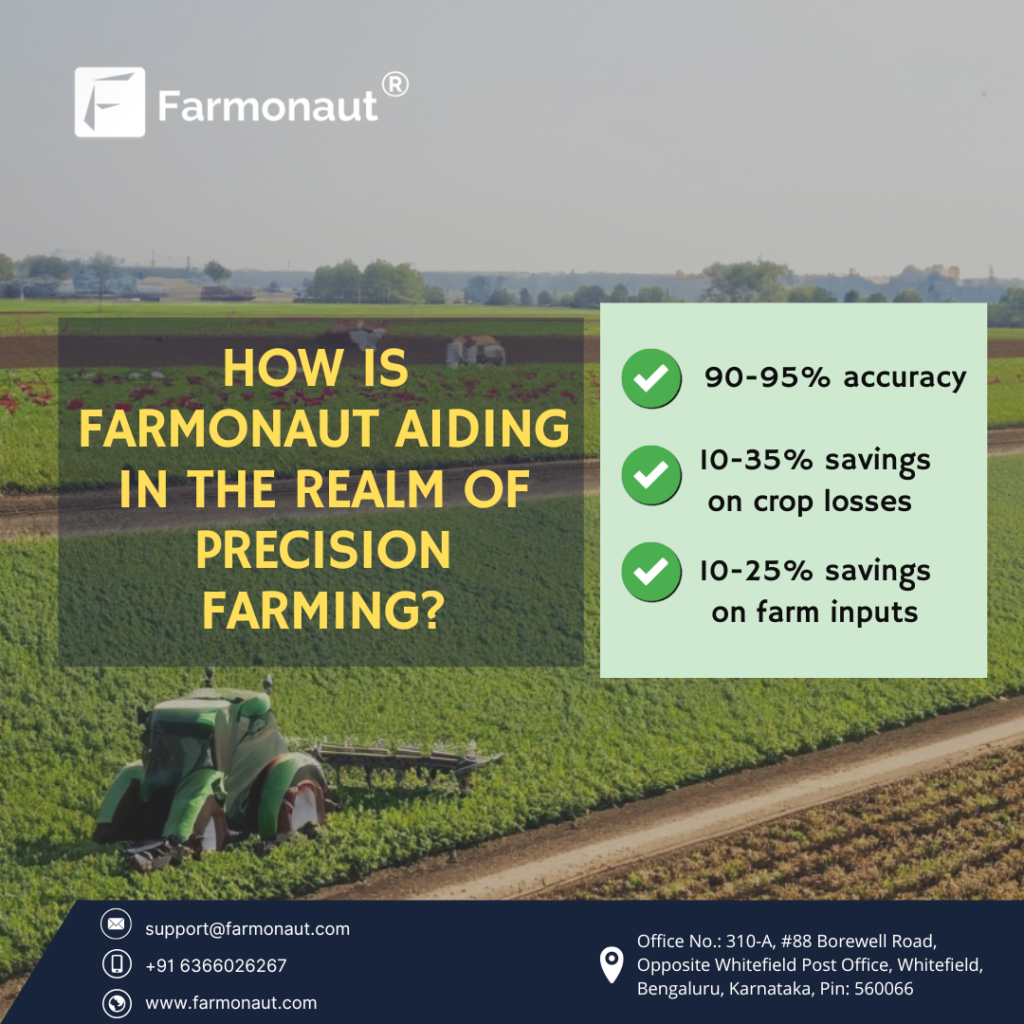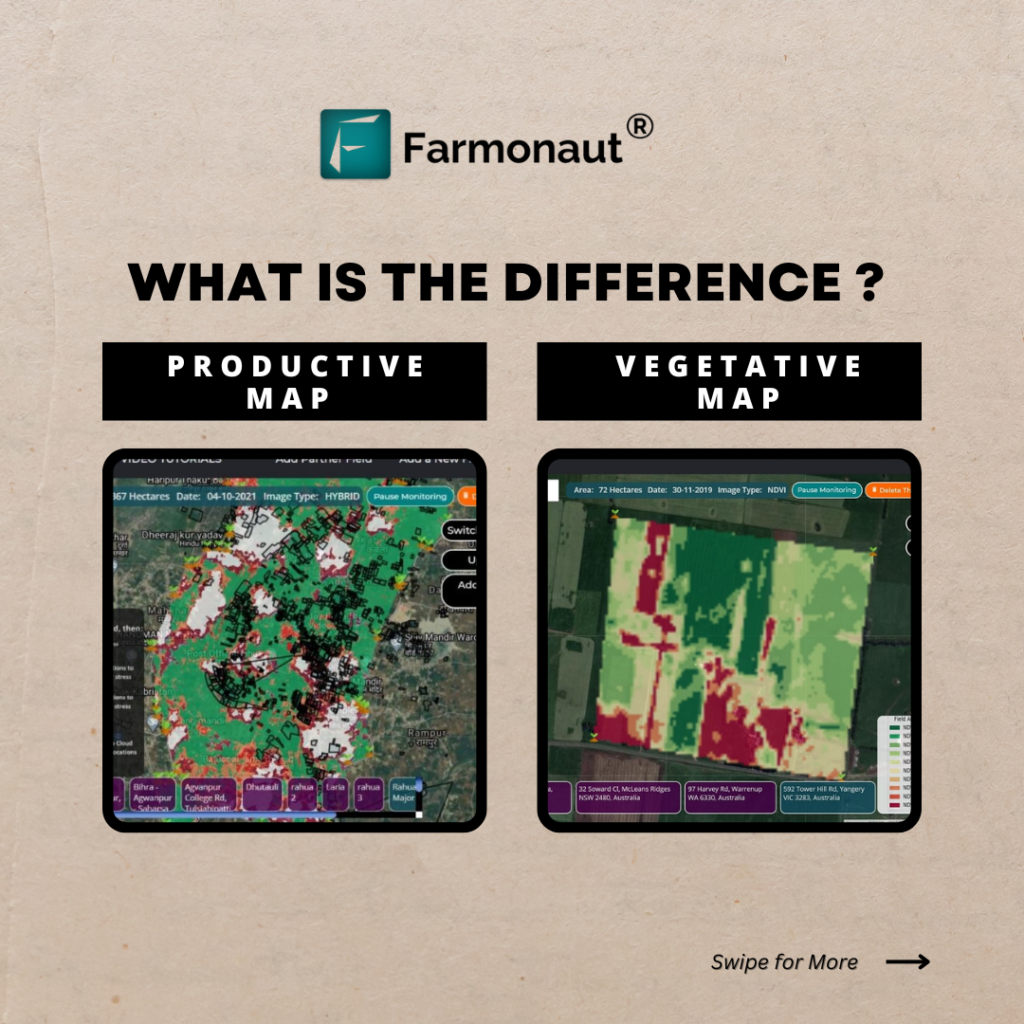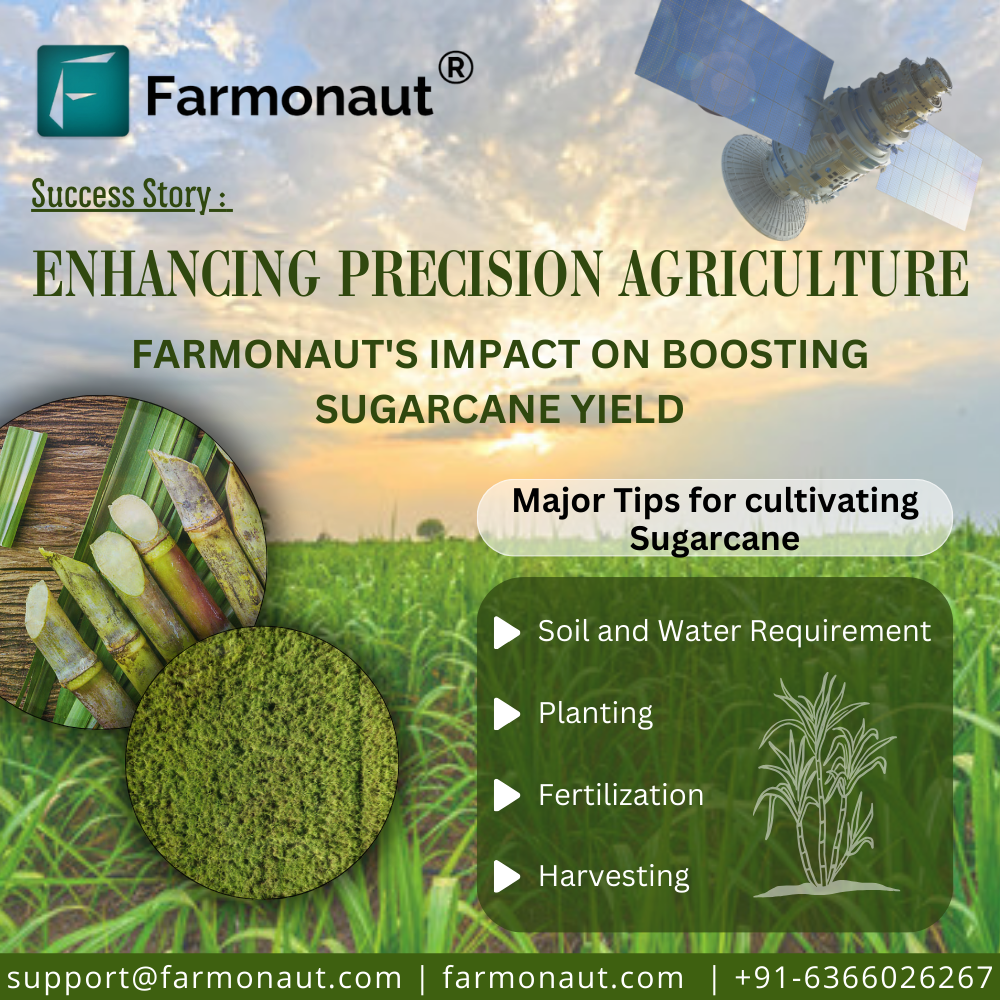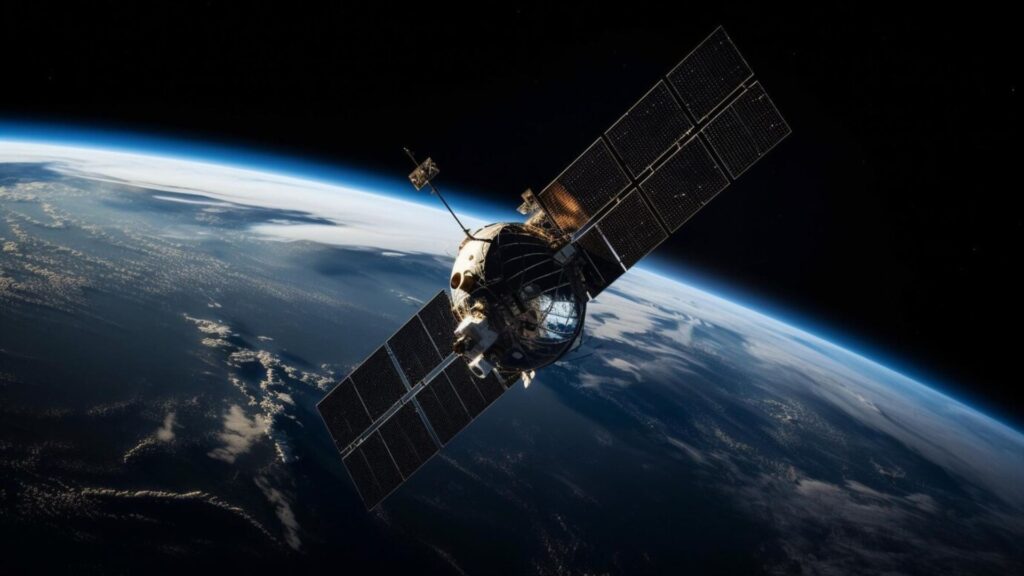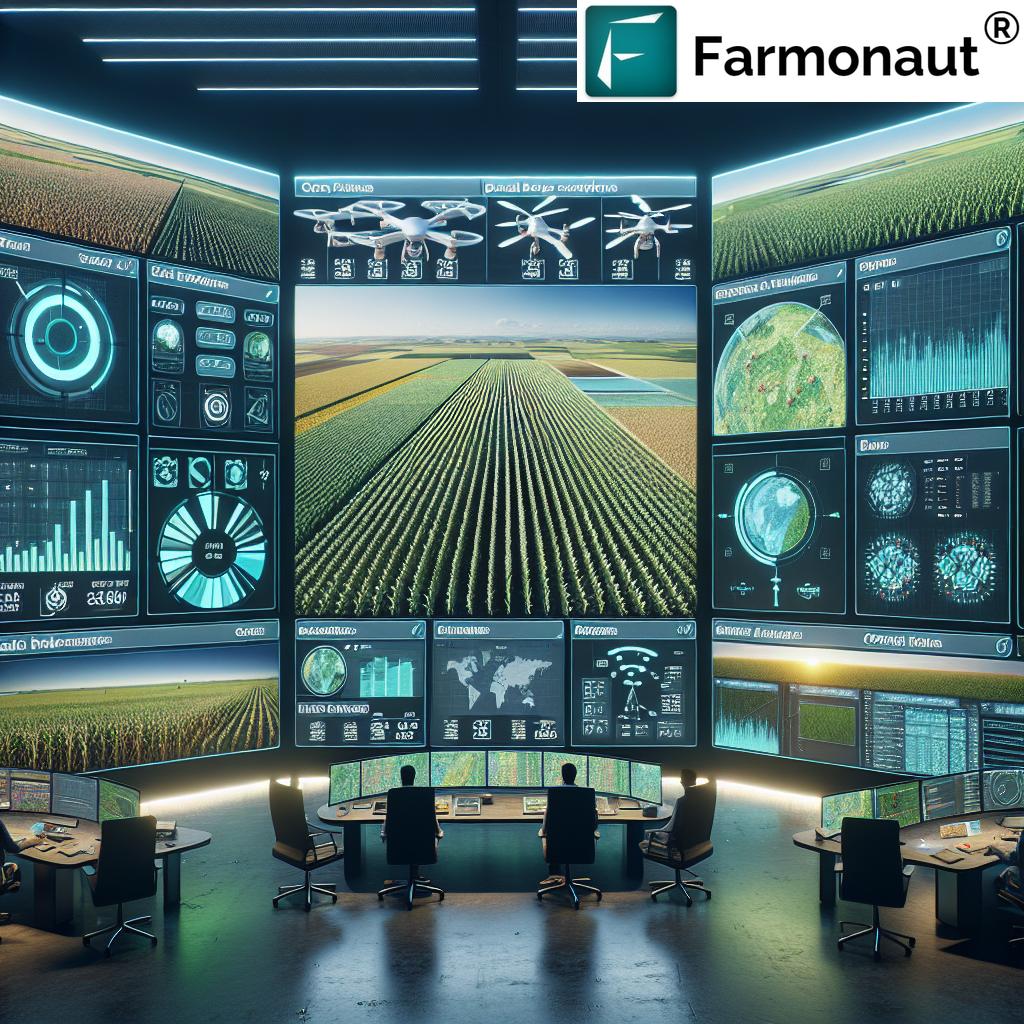
Revolutionize Farming with Precision Agriculture Technology
In today’s rapidly evolving agricultural landscape, we find ourselves at the forefront of a technological revolution that promises to transform the way we grow, manage, and harvest crops. Precision agriculture technology has emerged as a game-changer, offering farmers and agronomists powerful tools to optimize their operations, increase yields, and promote sustainability. In this comprehensive guide, we’ll explore how these innovative solutions are reshaping the farming industry and how companies like Farmonaut are leading the charge in making these technologies accessible to farmers worldwide.
The Evolution of Precision Agriculture
Precision agriculture, also known as precision farming or smart farming, represents a paradigm shift in agricultural practices. By leveraging advanced technologies such as satellite imagery, drones, IoT sensors, and data analytics, farmers can now make highly informed decisions about every aspect of their operations. This approach allows for the optimization of inputs, reduction of waste, and improvement of overall farm performance.
The journey of precision agriculture began in the 1980s with the introduction of Global Positioning System (GPS) technology in farming equipment. Since then, it has rapidly evolved to encompass a wide range of technologies and methodologies, each contributing to more efficient and sustainable farming practices.
Key Components of Precision Agriculture Technology
Let’s delve into the core technologies that form the backbone of precision agriculture:
1. Satellite Imagery and Remote Sensing
Satellite imagery has revolutionized the way we monitor and analyze agricultural lands. By capturing multispectral images from space, we can gain valuable insights into:
- Crop health and vigor
- Soil moisture levels
- Pest and disease outbreaks
- Crop yield estimation
Companies like Farmonaut leverage advanced satellite technology to provide farmers with real-time data on their fields. This information enables timely interventions and more precise management of resources.
2. Drone Technology for Farming
Unmanned Aerial Vehicles (UAVs), commonly known as drones, have become indispensable tools for modern farmers. They offer several advantages:
- High-resolution field mapping
- Crop scouting and monitoring
- Targeted spraying of pesticides and fertilizers
- Assessment of crop damage after extreme weather events
Drones provide a cost-effective way to gather detailed information about field conditions, complementing satellite data and ground-level observations.
3. IoT Sensors and Connected Devices
The Internet of Things (IoT) has found a natural home in agriculture. Smart sensors deployed across fields can continuously monitor various parameters:
- Soil moisture and temperature
- Weather conditions
- Crop growth stages
- Equipment performance
These sensors feed data into centralized management systems, allowing for real-time monitoring and automated responses to changing conditions.
4. Data Analytics and Artificial Intelligence
The true power of precision agriculture lies in the ability to analyze vast amounts of data and extract actionable insights. Advanced analytics and AI algorithms can:
- Predict crop yields
- Optimize planting and harvesting schedules
- Detect early signs of crop stress or disease
- Generate personalized recommendations for each field
Farmonaut’s Jeevn AI Advisory System exemplifies this approach, providing farmers with tailored advice based on comprehensive data analysis.
5. Variable Rate Technology (VRT)
VRT allows farmers to apply inputs such as seeds, fertilizers, and pesticides at variable rates across their fields. This precision approach ensures that each area receives exactly what it needs, optimizing resource use and improving crop performance.
6. GPS-Guided Machinery
GPS-enabled tractors and other farm equipment can operate with centimeter-level accuracy, enabling:
- Precise planting and harvesting
- Reduced overlap in field operations
- Minimized soil compaction
- Improved fuel efficiency
The Impact of Precision Agriculture on Modern Farming
The adoption of precision agriculture technologies is transforming the farming industry in numerous ways:
1. Improved Crop Yields and Quality
By optimizing every aspect of crop production, from planting to harvest, precision agriculture helps farmers achieve higher yields and better crop quality. This is particularly crucial as we face the challenge of feeding a growing global population.
2. Resource Efficiency
Precision farming techniques allow for more efficient use of water, fertilizers, and pesticides. This not only reduces input costs but also minimizes the environmental impact of farming operations.
3. Environmental Sustainability
By reducing the use of chemicals and optimizing resource allocation, precision agriculture contributes to more sustainable farming practices. This aligns with growing consumer demand for environmentally responsible food production.
4. Data-Driven Decision Making
Access to real-time data and advanced analytics empowers farmers to make informed decisions based on objective information rather than gut feeling or tradition.
5. Risk Mitigation
Early detection of crop health issues, weather-related risks, and equipment problems allows farmers to take proactive measures, reducing the likelihood of significant losses.
6. Labor Optimization
Automation and smart machinery reduce the need for manual labor in many farming tasks, addressing labor shortages and improving overall farm efficiency.
Precision Agriculture Technologies in Action
Let’s explore how various precision agriculture technologies are being applied in real-world farming scenarios:
Crop Scouting Techniques
Modern crop scouting goes beyond visual inspection, incorporating advanced technologies to provide a comprehensive view of field conditions:
- Satellite-Based Monitoring: Regular satellite imagery allows for continuous tracking of crop health across large areas. Vegetation indices like NDVI (Normalized Difference Vegetation Index) help identify areas of stress or low productivity.
- Drone Surveys: Drones equipped with multispectral cameras can capture detailed images of crops, revealing issues that may not be visible to the naked eye.
- IoT Sensor Networks: In-field sensors provide real-time data on soil moisture, temperature, and other critical parameters, allowing for early detection of potential problems.
These technologies enable farmers and agronomists to scout their fields more efficiently, focusing their attention on areas that require immediate intervention.
Field Data Management
Effective field data management is crucial for making informed decisions in precision agriculture. Modern systems offer:
- Centralized Data Storage: All field-related data, including historical records, sensor readings, and satellite imagery, is stored in a single, easily accessible platform.
- Data Visualization: Advanced mapping and charting tools help farmers and agronomists visualize complex data sets, making it easier to identify trends and patterns.
- Integration with Farm Management Software: Field data seamlessly integrates with other farm management tools, enabling comprehensive planning and decision-making.
Farmonaut’s platform exemplifies this approach, offering a user-friendly interface for managing and analyzing field data from various sources.
Satellite Imagery in Agriculture
Satellite technology has become an indispensable tool in modern agriculture, offering numerous benefits:
- Wide-Area Coverage: Satellites can monitor vast agricultural regions, providing a comprehensive view of crop conditions across entire countries or continents.
- Frequent Updates: Regular satellite passes ensure that farmers have access to up-to-date information about their fields, often on a weekly or even daily basis.
- Multispectral Analysis: By capturing data across multiple spectral bands, satellites can reveal information about crop health, soil moisture, and other factors that are invisible to the human eye.
- Historical Data: Long-term satellite records allow for year-over-year comparisons and trend analysis, helping farmers make more informed decisions about crop rotation and land use.
Farmonaut’s satellite-based crop health monitoring system leverages these capabilities to provide farmers with actionable insights for improving their operations.
Variable Rate Prescriptions
Variable rate technology (VRT) allows for precise application of inputs based on the specific needs of different areas within a field:
- Fertilizer Application: By analyzing soil nutrient levels and crop requirements, VRT systems can create detailed fertilizer prescriptions, ensuring that each part of the field receives the optimal amount of nutrients.
- Seeding: Variable rate seeding adjusts planting density based on soil conditions, topography, and historical yield data, optimizing plant population for maximum productivity.
- Pesticide and Herbicide Application: Targeted application of crop protection products reduces overall chemical use while ensuring effective pest and weed control.
- Irrigation: Variable rate irrigation systems adjust water application based on soil moisture levels and crop water requirements, conserving water and preventing over- or under-watering.
These precision techniques not only improve crop performance but also contribute to more sustainable and environmentally friendly farming practices.
Crop Performance Analysis
Advanced analytics tools enable farmers to gain deep insights into crop performance throughout the growing season:
- Yield Prediction: By analyzing historical data, current field conditions, and weather forecasts, AI-powered systems can provide accurate yield predictions, helping farmers plan for harvest and marketing.
- Growth Stage Monitoring: Automated systems track crop development stages, alerting farmers when specific interventions or treatments are needed.
- Benchmarking: Farmers can compare their crop performance against regional averages or top performers, identifying areas for improvement.
- ROI Analysis: Detailed performance data allows for accurate calculation of return on investment for different inputs and management practices.
These analytical capabilities empower farmers to make data-driven decisions that optimize their operations and improve profitability.
Digital Agriculture Solutions
The integration of digital technologies is transforming every aspect of farm management:
- Farm Management Software: Comprehensive platforms like Farmonaut provide a central hub for all farm-related data and operations, from field mapping to financial planning.
- Mobile Apps: Smartphone applications allow farmers to access critical information and control farm systems from anywhere, enhancing flexibility and responsiveness.
- Cloud Computing: Cloud-based solutions enable seamless data sharing and collaboration among farmers, agronomists, and other stakeholders.
- Blockchain Technology: Farmonaut’s blockchain-based traceability system ensures transparency and security in agricultural supply chains, from farm to consumer.
These digital tools are making farming more efficient, transparent, and connected than ever before.
Field Health Monitoring
Continuous monitoring of field health is crucial for early detection and prevention of crop issues:
- Remote Sensing: Satellite and drone imagery provide regular updates on crop vigor, allowing for quick identification of problem areas.
- In-Field Sensors: IoT devices monitor soil conditions, microclimate, and plant health in real-time, alerting farmers to potential issues before they become visible.
- Disease and Pest Modeling: Advanced algorithms combine weather data, crop information, and historical patterns to predict the likelihood of disease or pest outbreaks, enabling preemptive action.
- Stress Detection: Multispectral analysis can reveal plant stress due to factors like drought, nutrient deficiencies, or pest damage, often before symptoms are visible to the human eye.
By leveraging these monitoring technologies, farmers can maintain optimal field health throughout the growing season, minimizing losses and maximizing productivity.
Agronomic Decision Making
Precision agriculture technologies are revolutionizing the way agronomic decisions are made:
- Data-Driven Recommendations: AI-powered systems like Farmonaut’s Jeevn AI analyze multiple data sources to provide personalized recommendations for crop management, taking into account factors such as soil type, weather patterns, and crop history.
- Scenario Modeling: Advanced software allows agronomists to model different management scenarios and predict their outcomes, helping to optimize decision-making.
- Real-Time Adjustments: With access to up-to-date field data, farmers can make rapid adjustments to their management practices in response to changing conditions.
- Collaborative Decision-Making: Digital platforms facilitate knowledge sharing and collaboration between farmers, agronomists, and researchers, leading to more informed and effective decision-making.
These tools empower farmers and agronomists to make more precise, timely, and effective decisions throughout the growing season.
Smart Farming Applications
The concept of smart farming extends beyond crop production to encompass all aspects of agricultural operations:
- Livestock Management: IoT sensors and RFID tags enable real-time monitoring of animal health, behavior, and productivity.
- Greenhouse Automation: Smart systems control temperature, humidity, lighting, and irrigation in greenhouse environments, optimizing conditions for plant growth.
- Precision Forestry: Remote sensing and GIS technologies are applied to forest management, improving inventory assessments and sustainability practices.
- Aquaculture Monitoring: Advanced sensors and analytics optimize feeding, water quality, and fish health in aquaculture operations.
These smart farming applications demonstrate the versatility of precision agriculture technologies across different agricultural sectors.
Agricultural Data Connectivity
Seamless data connectivity is the backbone of precision agriculture systems:
- IoT Networks: Low-power, wide-area networks (LPWAN) enable reliable communication between in-field sensors and central management systems, even in remote areas.
- Data Standardization: Efforts to standardize agricultural data formats and protocols are improving interoperability between different systems and platforms.
- Edge Computing: On-farm processing of data reduces reliance on constant internet connectivity and enables faster decision-making.
- API Integration: Farmonaut’s API services allow for easy integration of satellite and weather data into third-party applications, fostering innovation in the agtech ecosystem.
These connectivity solutions ensure that farmers have access to critical data and insights wherever and whenever they need them.
Crop Protection Strategies
Precision agriculture is transforming crop protection practices, making them more targeted and environmentally friendly:
- Precision Spraying: GPS-guided sprayers and drone-based application systems allow for highly targeted application of pesticides and herbicides, reducing overall chemical use.
- Integrated Pest Management (IPM): Advanced monitoring and modeling tools support more effective IPM strategies, combining biological, cultural, and chemical control methods.
- Resistant Variety Selection: Data-driven insights help farmers choose crop varieties that are best suited to local conditions and pest pressures.
- Biological Control: Precision monitoring helps optimize the timing and placement of biological control agents, improving their effectiveness.
These advanced crop protection strategies not only improve pest and disease management but also contribute to more sustainable farming practices.
Soil Fertility Management
Precision agriculture enables a more nuanced approach to soil fertility management:
- Grid Soil Sampling: High-resolution soil sampling provides detailed maps of soil nutrient levels, allowing for precise fertilizer application.
- Real-Time Nutrient Sensing: Advanced sensors can measure soil nutrient levels in real-time during field operations, enabling on-the-go adjustment of fertilizer application rates.
- Cover Crop Management: Satellite imagery and drone surveys help optimize cover crop strategies for improved soil health and nutrient retention.
- Precision Liming: Variable rate lime application based on detailed pH maps ensures optimal soil conditions across the field.
These precision techniques help farmers maintain optimal soil fertility while minimizing environmental impact and reducing input costs.
Farm Data Visualization
Effective visualization of farm data is crucial for turning raw information into actionable insights:
- Interactive Maps: GIS-based mapping tools allow farmers to visualize various layers of field data, from soil types to crop health indices.
- Time-Series Analysis: Graphical representations of data over time help identify trends and patterns in crop performance and field conditions.
- 3D Terrain Modeling: Advanced visualization techniques provide insights into field topography and its impact on water flow and crop growth.
- Augmented Reality (AR): Emerging AR technologies overlay digital information onto real-world views of the field, enhancing in-field decision-making.
Farmonaut’s platform offers robust visualization tools that help farmers and agronomists interpret complex data sets and make informed decisions.
Precision Farming Software
Sophisticated software platforms are at the heart of precision farming operations:
- Data Integration: Advanced software systems aggregate data from multiple sources, including satellites, drones, IoT sensors, and farm equipment.
- Analytics and Modeling: AI and machine learning algorithms process vast amounts of data to generate insights and predictions.
- Prescription Generation: Software tools create detailed prescriptions for variable rate applications of seeds, fertilizers, and other inputs.
- Reporting and Compliance: Automated reporting features help farmers meet regulatory requirements and sustainability standards.
Farmonaut’s comprehensive software solution exemplifies the power of integrated precision farming platforms, offering a suite of tools for farm management, analysis, and decision support.
Agricultural Research Facilities
Precision agriculture technologies are also transforming agricultural research:
- High-Throughput Phenotyping: Advanced imaging and sensor technologies enable rapid assessment of plant traits in research plots.
- Climate-Controlled Environments: Precision-controlled growth chambers and greenhouses allow for detailed study of crop responses to various environmental factors.
- Field-Scale Experiments: GPS-guided machinery and remote sensing technologies facilitate large-scale field trials with unprecedented accuracy and data collection capabilities.
- Data Management and Analysis: Sophisticated software tools help researchers manage and analyze the vast amounts of data generated by modern agricultural experiments.
These advanced research capabilities are accelerating the development of new crop varieties, management practices, and agricultural technologies.
Crop Yield Optimization
Precision agriculture offers multiple pathways for optimizing crop yields:
- Site-Specific Management: By tailoring management practices to the specific conditions of each part of the field, farmers can maximize productivity across variable landscapes.
- Predictive Analytics: Advanced modeling techniques help farmers anticipate and mitigate factors that could limit yield potential.
- Precision Harvesting: GPS-guided harvesters and yield monitoring systems provide detailed maps of crop productivity, informing future management decisions.
- Post-Harvest Analysis: Detailed yield data allows for thorough analysis of the effectiveness of various management practices, driving continuous improvement.
These yield optimization strategies help farmers achieve higher and more consistent yields while optimizing resource use.
Remote Sensing in Agriculture
Remote sensing technologies provide valuable insights across various agricultural applications:
- Crop Classification: Satellite imagery enables accurate mapping and classification of crop types across large areas, supporting agricultural planning and policy-making.
- Biomass Estimation: Advanced algorithms use remote sensing data to estimate crop biomass and potential yield, informing management decisions and market forecasts.
- Drought Monitoring: Satellite-based indices help track drought conditions and their impact on crop health, supporting risk management and irrigation planning.
- Flood Mapping: Remote sensing techniques assist in rapid assessment of flood extent and impact on agricultural lands, aiding in disaster response and recovery efforts.
Farmonaut’s satellite-based monitoring system leverages these remote sensing capabilities to provide farmers with comprehensive insights into their fields and surrounding landscapes.
AgTech Innovations
The field of agricultural technology (AgTech) is rapidly evolving, with new innovations emerging regularly:
- Robotics and Automation: Autonomous tractors, pruning robots, and harvesting machines are reducing labor requirements and improving efficiency.
- Vertical Farming: Advanced lighting, hydroponics, and climate control systems are enabling highly efficient indoor crop production.
- Gene Editing: CRISPR and other gene-editing technologies are accelerating the development of crops with improved traits for yield, disease resistance, and nutrition.
- Artificial Intelligence: AI is being applied to various aspects of agriculture, from crop disease detection to optimizing supply chains.
These cutting-edge technologies are shaping the future of agriculture, promising even greater levels of productivity, sustainability, and resilience.
Precision Agriculture Around the World
The adoption of precision agriculture technologies varies across different regions, influenced by factors such as farm size, crop types, technological infrastructure, and government policies. Let’s explore how precision farming is taking shape in various parts of the world:
United States
The United States has been at the forefront of precision agriculture adoption, with a significant percentage of large-scale farms implementing these technologies. Key aspects include:
- Widespread use of GPS-guided machinery and auto-steering systems
- Extensive adoption of variable rate technology for fertilizer and seed application
- Growing implementation of data-driven decision support systems
- Strong research and development in AgTech, particularly in states like Iowa and California
Europe
European countries, particularly in Western Europe, have embraced precision agriculture as part of their efforts to promote sustainable farming practices:
- Strong focus on reducing environmental impact through precise input management
- Adoption of precision irrigation systems in water-scarce regions
- Implementation of farm management software for compliance with EU regulations
- Leading research in precision viticulture and horticulture
South America
Large-scale farming operations in countries like Brazil and Argentina have been quick to adopt precision agriculture technologies:
- Extensive use of satellite imagery for monitoring vast agricultural areas
- Adoption of precision planting systems for row crops like soybeans and corn
- Implementation of variable rate technology for fertilizer application
- Growing interest in precision agriculture for sustainable Amazon farming
Asia
Precision agriculture adoption in Asia varies widely, with countries like Japan and South Korea leading in technology implementation:
- Development of precision agriculture solutions for smallholder farmers
- Adoption of drone technology for crop spraying and monitoring
- Implementation of smart farming systems in greenhouse production
- Growing interest in precision agriculture for rice cultivation
Africa
While adoption is still in early stages in many African countries, there is growing interest in precision agriculture technologies:
- Use of mobile apps for agricultural information and market access
- Implementation of solar-powered IoT systems for small-scale irrigation
- Adoption of satellite-based crop monitoring for food security programs
- Growing research into precision agriculture solutions for smallholder farmers
Australia
Australian farmers have been early adopters of precision agriculture, driven by the need to optimize resources in challenging environmental conditions:
- Extensive use of GPS-guided machinery for broadacre farming
- Adoption of variable rate technology for managing soil variability
- Implementation of precision irrigation systems in water-scarce regions
- Leading research in precision livestock management
As precision agriculture technologies continue to evolve and become more accessible, we expect to see increased adoption across all regions, with solutions tailored to local farming conditions and needs.
The Role of Farmonaut in Precision Agriculture
Farmonaut stands at the forefront of the precision agriculture revolution, offering innovative solutions that make advanced farming technologies accessible to farmers worldwide. Let’s explore how Farmonaut’s platform is contributing to the transformation of agriculture:
Satellite-Based Crop Health Monitoring
Farmonaut’s satellite imagery system provides farmers with regular updates on crop health and field conditions. Key features include:
- High-resolution multispectral imagery for detailed crop analysis
- NDVI (Normalized Difference Vegetation Index) mapping for assessing plant vigor
- Soil moisture monitoring to optimize irrigation practices
- Early detection of crop stress, pests, and diseases
Jeevn AI Advisory System
This advanced AI-powered tool delivers personalized recommendations to farmers, helping them make informed decisions throughout the growing season:
- Real-time insights based on satellite data, weather forecasts, and historical patterns
- Customized crop management strategies tailored to specific field conditions
- Predictive analytics for yield estimation and risk assessment
- Continuous learning and improvement through machine learning algorithms
Blockchain-Based Traceability
Farmonaut’s blockchain technology ensures transparency and security in agricultural supply chains:
- End-to-end traceability from farm to consumer
- Secure and immutable record-keeping for all stages of production
- Enhanced trust and authenticity for food products
- Support for sustainable and ethical farming practices
Fleet and Resource Management
Farmonaut offers tools to optimize the management of agricultural machinery and resources:
- Real-time tracking and monitoring of farm equipment
- Optimization of vehicle routes and field operations
- Maintenance scheduling and performance monitoring
- Improved efficiency and reduced operational costs
Carbon Footprint Tracking
In response to growing environmental concerns, Farmonaut provides carbon footprint monitoring capabilities:
- Real-time tracking of greenhouse gas emissions from farming operations
- Tools for implementing and measuring sustainable farming practices
- Support for carbon credit programs and environmental certifications
- Assistance in meeting regulatory requirements for emissions reporting
API Access for Developers
Farmonaut’s API services enable integration of its powerful tools into other agricultural applications:
- Access to satellite imagery and weather data for custom applications
- Integration of Farmonaut’s analytics and advisory services into third-party platforms
- Support for innovation and collaboration within the AgTech ecosystem
By offering these comprehensive and accessible precision agriculture solutions, Farmonaut is empowering farmers to embrace the future of farming, regardless of their scale of operation or technological expertise.
Comparison of Precision Agriculture Technologies
To better understand the landscape of precision agriculture technologies and Farmonaut’s unique position, let’s compare different approaches:
| Technology | Data Source | Key Benefits | Farmonaut Advantage |
|---|---|---|---|
| Satellite Imagery | Multispectral satellite sensors |
– Wide area coverage – Regular updates – Historical data availability |
– Advanced multispectral analysis – AI-powered insights – Affordable access for all farm sizes |
| Drone Mapping | UAV-mounted cameras and sensors |
– High-resolution imagery – On-demand data collection – Flexible sensor options |
– Complements satellite data for detailed analysis – Integration with Farmonaut’s analytics platform |
| IoT Sensors | In-field electronic sensors |
– Real-time data collection – Precise local measurements – Continuous monitoring |
– Integration with satellite and weather data – Holistic field health monitoring |
| Variable Rate Applications | GPS, yield maps, soil tests |
– Optimized input application – Resource efficiency – Improved crop performance |
– AI-generated prescriptions – Integration of multiple data sources – Continuous optimization |
This comparison highlights how Farmon


